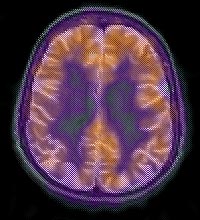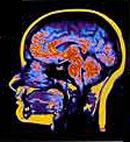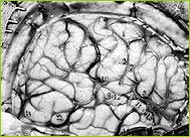| (insert your NIE or newspaper logo here) |
Weekly Online LessonOnline Lesson ArchiveGrade Level: 6-10
|
Understanding Alzheimer's Disease
 Americans mourned the death of a leader on Saturday, June 5, 2004, when former President Ronald Reagan passed away from complications caused by Alzheimer's Disease (AD).
Americans mourned the death of a leader on Saturday, June 5, 2004, when former President Ronald Reagan passed away from complications caused by Alzheimer's Disease (AD).
AD is a disease that creates abnormal clumps and bundles of fibers in the brain, causing the loss of nerve cells in areas that are vital to memory and other mental abilities.
Reagan, formerly a Hollywood actor and California senator, was elected the 40th President of the United States at age 69, the oldest person in history to enter that office. He served two terms, from 1981 to 1989, during which he survived an assassination attempt, appointed the first female Supreme Court Justice, and achieved the highest approval rating of any president since Franklin D. Roosevelt.
Within a few years of leaving office, however, stories of his frequent forgetfulness seeped into the news media. Then in 1994, the former president announced that he had been diagnosed with Alzheimer's. By 2000, his physical and mental functions had noticeably worsened and he was unable to recognize anyone except his wife, Nancy. During his final months, even she had escaped his memory.
In a recent letter, Nancy Reagan wrote, "Those who have Alzheimer's are on a rocky path that only goes downhill. Ronnie's long journey has taken him to a distant place where I can no longer reach him. We cannot share the wonderful memories of our years together." The couple married in 1952.
More than 4 million Americans -- about one in 10 people over age 65 -- have been diagnosed with AD, but many more people are affected by its progression. Shared memories, like those of the Reagans, are lost, and often a patient's primary caregiver is a close friend or relative, setting a heavy emotional and economic burden on those individuals.
Fortunately, Reagan's condition helped raise awareness of the disease and boosted research efforts for treating and preventing this disease of the brain. So for this week's lesson, you're going to learn what experts have discovered so far about Alzheimer's. You'll also explore how the brain works, and how it changes as we age.
The Knowns and Unknowns of Alzheimer's Disease
 Begin learning about Alzheimer's Disease at the KidsHealth site.
Begin learning about Alzheimer's Disease at the KidsHealth site.
Read the introduction, then move on to the Next Page, to find out what some of the causes and effects of the disease are.
How exactly does the disease affect the brain's normal functioning? At about what age does the disease usually show up? What factors can boost a person's risk of getting the disease? What are the steps a doctor usually takes to determine if a patient has Alzheimer's?
On the Next Page, read a little about what life is like for AD patients. What kinds of activities can you enjoy doing with a loved one who has Alzheimer's? In what ways can you help to lower your own risk of getting AD as you age?
Now let's dig up some details about this disease at the Alzheimer's Disease Education & Referral Center. Who was the first person to diagnose the disease? What exactly did he discover? What year was it documented? How does dementia affect a person's behavior?
If you have RealOne Player on your computer, watch the movie illustrating the Alzheimer's Disease Process. What role do neurons play in the brain's functioning? What is the relationship between the chemical messages and the electrical charges that run through the brain?
What is "tau," and what happens to it when Alzheimer's takes hold? In what ways does that affect how the brain and body function?
Work On the Brain
 As a whole, our brains work 24/7. Even asleep, our brains make sure we do things like dream and breathe. But not every part of the brain works at the same time. What area of the brain is getting used depends on what we're doing, as well as on our mental and physical well-being.
As a whole, our brains work 24/7. Even asleep, our brains make sure we do things like dream and breathe. But not every part of the brain works at the same time. What area of the brain is getting used depends on what we're doing, as well as on our mental and physical well-being.
Our brains are not only making decisions and making our body respond to our needs, however. They are also constantly changing as we age, have new experiences, form new habits, and create new memories.
To get an idea of how all of this happens -- and how humans have figured (and not figured) it out -- let's surf over to Thirteen/WNET and uncover The Secret Life of the Brain.
Start with the Web Features menu on the left side of the page, and travel through The History of the Brain. Browse the timeline by clicking Next or on a specific year.
When did Alcmaeon conclude that the brain, not the heart, is the central organ of thought? What research methods did he use to produce his findings? When was the first human body dissected to compare with other living organisms?
What medical condition did James Parkinson first describe in 1817? How did Sigmund Freud characterize the relationship between dreams and wakefulness? Why was the discovery of prions in 1997 an important step in understanding how Alzheimer's Disease works?
 Okay, so now let's check out some 3-D Brain Anatomy -- a cool way to get some insight into how medical studies over the years have shaped what we know about how the brain works.
Okay, so now let's check out some 3-D Brain Anatomy -- a cool way to get some insight into how medical studies over the years have shaped what we know about how the brain works.
Click on every different part of the brain to find out what that area is called and what behavior it governs. The, explore the brain By Function using the pull-down list. Use the viewer's navigation tools to zoom in or get a 360-degree view of each area.
What area of the brain is responsible for short-term memory? How about long-term memory? What part of the brain controls movement, and where is it located? How does the brain's different areas work with other parts of our body to do things like hear, see, smell, taste, and touch?
How do scientists know so much about which part of the brain controls what functions? Thanks to scientific and technological progress, Scanning the Brain has certainly raised our awareness of things going on in our heads. Check out the different types of scans -- EEG, CAT, PET, MRI, and MEG. Click Next to move through the multiple MRI pages.
What exactly does each method detect?
Next, hop into The Episodes section. First take a look at The Baby's Brain and review the episode feature, Infant Vision and the Additional Video Clips.
 Now compare that to The Child's Brain. What role does Motherese (or "Caretakerese") play in creating our maps of speech?
Now compare that to The Child's Brain. What role does Motherese (or "Caretakerese") play in creating our maps of speech?
Also watch the Additional Video Clips. Why do you think language is important in our early development? In what ways do you think other experiences strengthen certain connections within the brain?
For many parents, The Teenage Brain can be a challenge. However, it can be an even greater challenge for the teen, as he or she goes through a number of changes during adolescence. In this section, also find out, Why do we sleep?, then watch the Additional Video Clips.
As you'll soon discover in The Adult Brain, emotions play a huge role in how our brain functions, and the study of Laughter has provided a few clues. Also view the Additional Video Clips to find out how a stroke can affect the emotional brain.
Lastly, explore The Aging Brain. What long-held medical belief about the aging brain has been generally rejected because of new discoveries? Make sure to also find out what progress has been made Towards an Alzheimer's Cure, and watch the Additional Video Clips describing memories in the aging brain and how the hippocampus reacts when we learn something new.
So what kinds of things should you do -- or not do -- to help keep your brain healthy your whole life? In what ways could you help younger children "grow" their brains? How could you help older people keep their brains sharp?
Newspaper Activities
Look through current issues of Targetnewspaper and look for stories about someone with Alzheimer's Disease, someone who has taken care of an AD patient, or those reporting any medical news about AD or other disease or condition that affects the brain. If the story features people facing AD, what aspects of their lives does the disease affect the most? If the news article is medical-related, have scientists discovered new information that helps them to better understand how the brain functions? Could the findings possibly lead to a cure for AD or some other brain-related illness?
© Copyright 2004
Learners
Online,
Inc.
